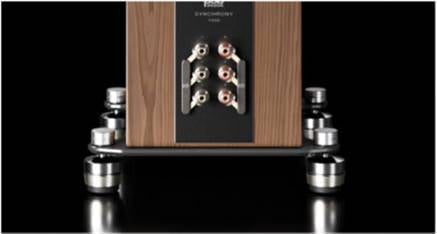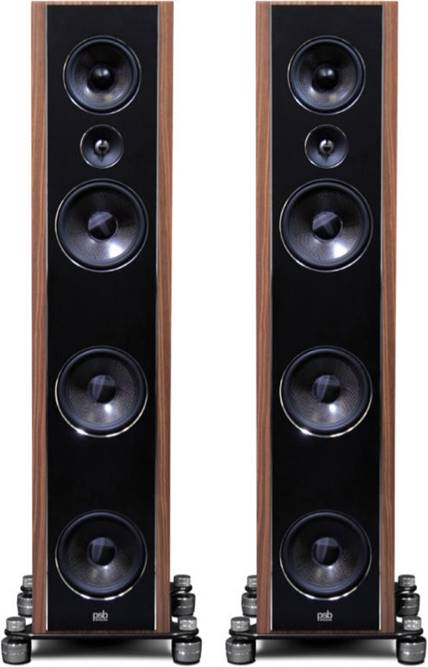PSB Synchrony T600 Review: Nice & Easy
One of the loudspeakers that I owned in my audio infancy was the full-range PSB Stratus Goldi. Compared to my Snell E/IV, it offered a grand sound, not to mention a very attractive gleaming piano-black finish. So, when TAS editor Robert Harley mentioned the prospect of reviewing PSB’s new flagship loudspeaker, it brought back nostalgic memories of the heady days of the late 1990s—an era when I was a stereo newbie, and America experienced what, in retrospect, seems like a golden age of peace and prosperity. I was eager to come sonically home again, as it were, to audition PSB’s Synchrony T600. How much progress had PSB made in the intervening decades?
Jacob Heilbrunn
PSB has the luxury of being able to employ the Canadian National Research Council’s testing labs for accurate measurements. This is likely one reason that PSB’s founder, Paul Barton, has consistently produced loudspeakers that can offer a bigger-than-normal bang for the buck. While the Stratus Goldi sounded a little bulky in the bass, my experience with the T600 suggested that PSB has moved in a different direction. It sounds very much like a loudspeaker that has been carefully designed for as linear a sound as possible, given the constraints of its cabinet size. This means that there don’t appear to be any severe frequency anomalies, bumps, or dips in the T600’s reproduction of music. Instead, it offers a tuneful, if limited, bass range, a highly articulate midrange, and extended highs. Before I commit hyster- on-proteron, it’s worth looking at the construction of the T600, which helps to explain its soothing sonic qualities.
Start with the aesthetics: It’s obvious the svelte T600 is quite eye-catching. Constructed in China out of MDF, it comes in either a walnut or high-gloss black finish, with outrigger stabilizers and IsoAcoustic GAIA II feet. It not only features five drivers—a 1″ titanium-dome tweeter, a 5″ carbon-fiber midrange cone with 4” cast-basket, and three 6 1/2″ carbon-fiber woofers—but also three rear-facing ports.
The T600 is relatively easy to drive: Its sensitivity is rated at 91dB, and it presents a 4-ohm load. A robust but not extravagantly powerful amplifier is needed to drive this loudspeaker. The Dart- zeel NBH-108 Model 2 stereo amplifier that I used in tandem with the dCS Vivaldi stack had no problem whatever driving the T600.
The loudspeaker can be single-, bi-, or tri-wired. If you run the loudspeaker with a single wire, then you need to use the factory-supplied jumpers or rig up your own. Whether these options are strictly necessary is an open question. My own take would be that, absent the ability to employ an active crossover to bypass the internal crossover and trim the frequencies and slopes for each set of drivers to your heart’s desire, the utility of multiple wiring setups is pretty much nugatory. Indeed, they can be a recipe for trouble if the user isn’t careful about lining up the jumpers and speaker cables properly. I was fastidious about ensuring that the speaker cables were properly embedded inside the loudspeaker terminals, though it took a bit of work.
With all those drivers and ports, you might expect that the T600 would sound murky or bloated. Au contraire!. The relatively small size of the drivers in the T600 mirrors the larger move of the audio industry toward more precise and speedy transient response. Alacrity seems to be the name of the game these days. The T600 won’t slap you around or bludgeon you with deep bass. It’s more refined than that.
To my ear, the T600 emulated many of the qualities of a fine mini-monitor. This quality was conspicuously apparent on a Murray Perahia recording of Handel and Scarlatti piano sonatas for Sony. In particular on a Scarlatti Sonata in E major, the finesse of Perahia’s playing came through with great clarity. The transient response was excellent, with each note gently decaying—no, shimmering—into what seemed like an endless sonic landscape. The same went for a marvelous jazz recording by the British pianist Rob Barron on the album From This Moment On on the ubuntu label. This album has a rich, palpable sound, and the T600 nailed the transient response of Barron’s piano, which was set clearly in relief against Jeremy Brown’s bass and Josh Morrison’s drums. But most beguiling is that the T600 conveyed a sense of the group playing in unison, rather than simply delivering three separate instruments in space playing independently. Put otherwise, it delivered a sense of drive and spontaneity that is the lifeblood of a jazz trio.
In the midband, the sonic character of the T600 can be described as creamy. On an LP that I recently picked up in Los Angeles by the saxophonist Teddy Edwards called Sunset Eyes on the Pacific jazz label, the T600 did an excellent job of capturing Edwards’ soulful sound, as well as the jaunty piano playing of Joe Castro. I’d never heard of Edwards before, but his playing was quite captivating on this LP, imaginative and innovative even as it was clearly rooted in the swing era, by which I mean to say it was lyrical. No sheets of sound here, just music. The transient accuracy of the T600 meant that even on this older recording—61 years old to be exact!—the piano chords were fully audible rather than fractured. The bass playing of Ben Tucker was also a pleasure to follow, with each pluck fully discernible— probably more discernible than it would have been in real life, to be honest. Something similar happened on a superb Pablo pressing, Kansas City 3. Ray Brown’s bass simply sounded exemplary on the initial cut “Sandman,” every nuance, every pluck so vividly rendered by the PSB. On the tune “On the Sunny Side of the Street,” the T600 allowed Basie’s fleet piano playing to shine, each note clearly enunciated. Louis Bellson’s drum solo on this number was no less impressive in its solidity and rapidity. Above all, the T600 permitted the emotional excitement of this joyous playing to be communicated.
The mellifluity of the T600 came through on a variety of music. On a recent recording of Bach arias by the German tenor Benjamin Appl, it was impossible to discern a trace of distortion. Instead, Ap- pl’s voice sounded robust, rich, and mellifluous. This might come as a surprise to those who believe that ti- tanium-dome tweeters are inherently harsh, but here voice and oboes each sounded exceptionally smooth and winning. Similarly, the T600 captured the roughness and subtle inflections of Leonard Cohen’s vocals on his final album, Thanks for the Dance [Sony], The low noise floor of the T600 allowed it to convey the short pauses in his singing, as well as his lingering on some phrases. The microdetails that it reproduced all combined to create what seemed like a credible simulacrum of Cohen singing in my listening room.
With its emphasis on the midband and its numerous smaller drivers, it shouldn’t come as a surprise that the T600 doesn’t deliver as lavish a sonic picture as larger and more expensive loudspeakers. On the song “All of Me” on the album Handful of Keys, Chris Crenshaw’s trombone solo did not have the weight that a bigger loudspeaker would deliver. Same goes for the dynamic crescendos on this tune. On orchestral works, it also isn’t quite as big and opulent. Orchestral layering and image stability were very good, but the T600 simply doesn’t dial it up the way the big boys would, at least in a large room. But really, this is no knock. In the hotly contested arena of loudspeakers priced under $15k, the T600 will more than carry its weight.
After employing much larger loudspeakers like the Wilson WAMM or the Mag- nepan 20.1 over the years, it was fascinating to listen to a smaller loudspeaker that provides a completely different sonic aperture. This loudspeaker will fit best into medium-sized rooms where it will provide a realistic sense of scale, one that is as captivating as it is convincing. There was absolutely no sense of this loudspeaker ever expanding a voice beyond its natural boundaries. Coupled to that was a presentation that is anchored to the floor rather than diffuse or disembodied. Nimble and silky, the T600 is enviably easy to enjoy for hour after hour. After a long interval in listening to PSB loudspeakers, I’m pleased to report that the company hasn’t simply upped its game; it has delivered a winner.

Specs & Pricing
Design: Five-way, three-port, floorstanding loudspeaker
Drivers: One titanium 1″ tweeter, one 5 1/4″ carbon-fiber midrange driver, three 6 1/2″ carbon-fiber woofers
Frequency response: 50Hz-33kHz (-3dB)
Nominal impedance: 4 ohms
Sensitivity: 91dB
Dimensions: 9″ x 41 1/4″ x 13 1/2″
Weight: 77 lbs.
PSB SPEAKERS
633 Granite Court
Pickering, Ontario
Canada L1W 3K1
(888) 772-0000
psbspeakers.com







